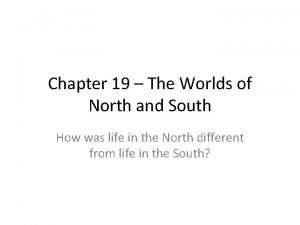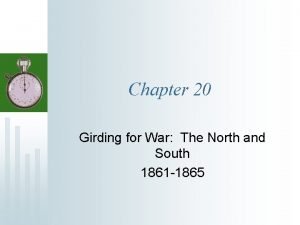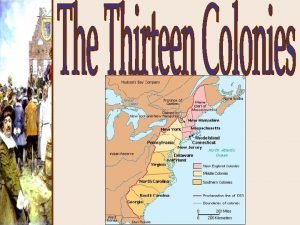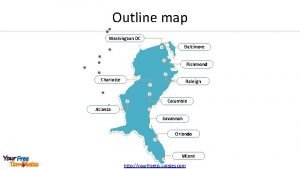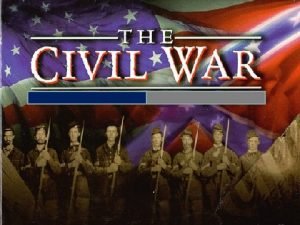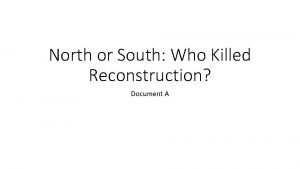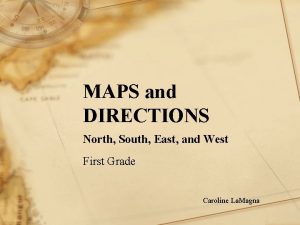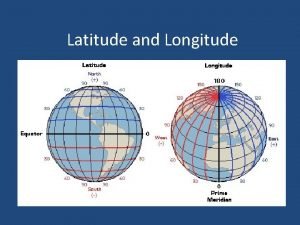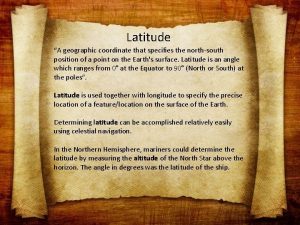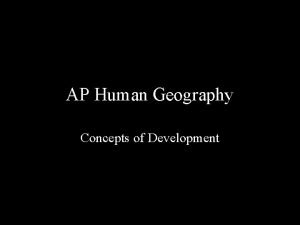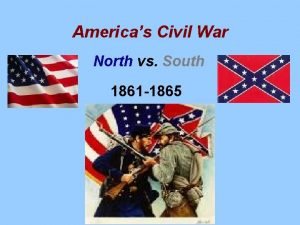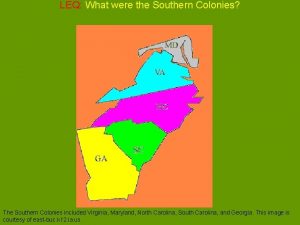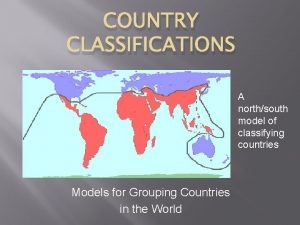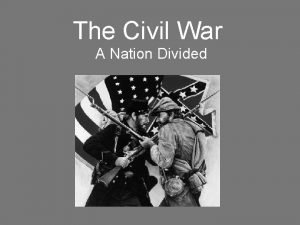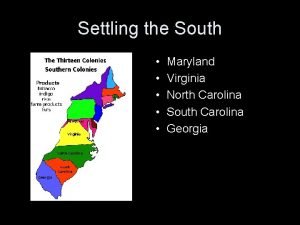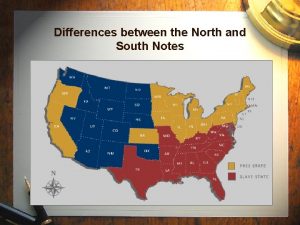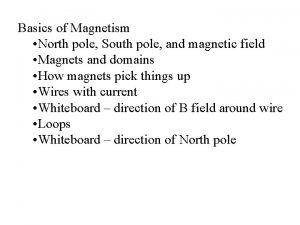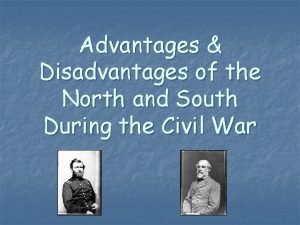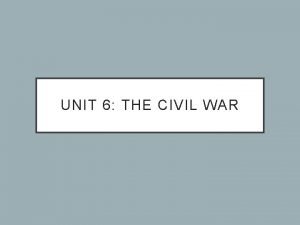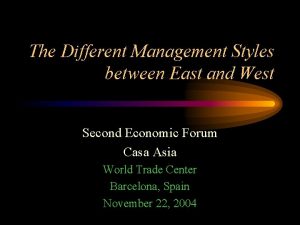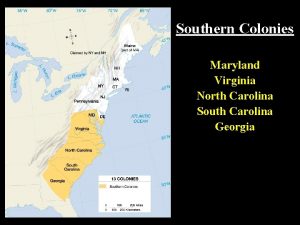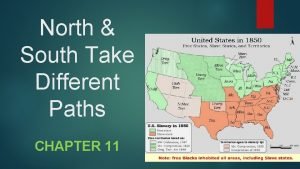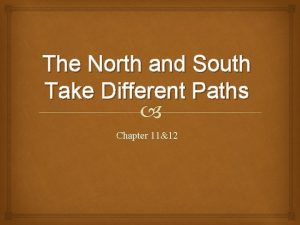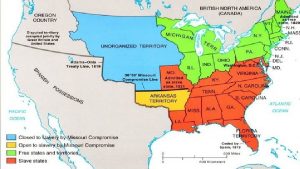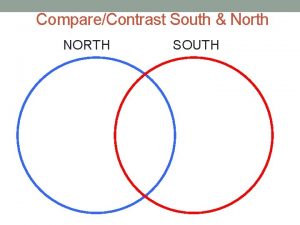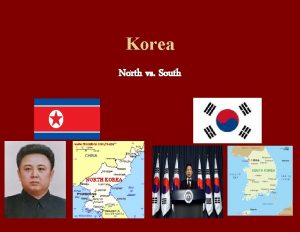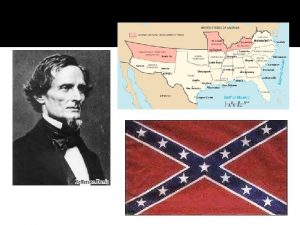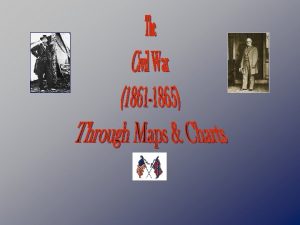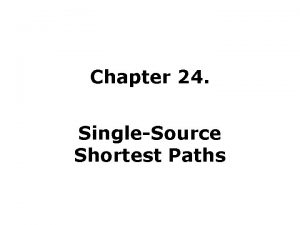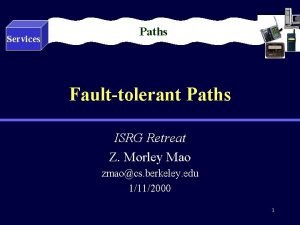North South Take Different Paths CHAPTER 11 The









































- Slides: 41

North & South Take Different Paths CHAPTER 11

The Industrial Revolution 11. 1

The Industrial Revolution 11. 1 Focus Question How did the new technology of the Industrial Revolution change the way Americans lived?

The Industrial Revolution 11. 1 1700 s – Industrial Revolution began Machines replaced hand tools Work done by people & horses replaced by water and then steam engines

The Industrial Revolution 11. 1 Began in GB with textile (cloth making) industry Previously, workers had spun thread in their homes on spinning wheels. The thread was then woven into cloth on hand looms. It took 1 person almost 2 weeks to produce a pound of cotton thread

https: //www. youtube. com/watch? v=ex 1 Atx 1 t. QPk

The Industrial Revolution 11. 1 1760 s – Invention of the spinning jenny Could now spin many strands at once; thread still had to be made by hand however,

The Industrial Revolution 11. 1 1764 – Richard Arkwright invented the water frame, a spinning machine powered by running water rather than human energy.


The Industrial Revolution 11. 1 Other inventions sped up the weaving process, so textile mills were built to house the large machines.

The Industrial Revolution 11. 1 The factory system developed – method of production bringing workers & machinery together in one place.

The Industrial Revolution 11. 1 The factory system required huge amounts of $$$ to be invested in buildings & machines. Mill owners went to capitalists, people who invest capital ($$$) into a business to earn profit.

The Industrial Revolution 11. 1 Factories = PROFITS!!! 1784 – British workers were producing 24 x as much thread as they had in 1765

The Industrial Revolution 11. 1 Factories dependent on riverbanks = PROBLEMS Dry seasons = no power Factories in rural areas = hard to find labor

The Industrial Revolution 11. 1 1790 – Arkwright built the first steam-powered textile plant The steam engine was a reliable source of power Factories could now be built in cities, where women & young children provided cheap labor




Antebellum towns including Macon, Milledgeville, Madison, and Greensboro experimented with steam-powered cotton factories, with varying degrees of success. Steam engines provided the means that made factory production increase astronomically

The Industrial Revolution 11. 1 GB wanted to keep its industrial success a secret. Laws forbade anyone to take information about textile machinery out of GB. Skilled workers were forbidden to leave the country.

The Industrial Revolution 11. 1 1789 – Samuel Slater (apprentice of Arkwright) immigrated to U. S. in order to sell the plans he’d smuggled out of Britain by memorization!

The Industrial Revolution 11. 1 Slater partnered with wealthy merchant, Moses Brown, who had rented a textile mill in Pawtucket, RI. Based solely on memory, Slater constructed a spinning machine based on Arkwright’s. The factory produced cotton thread faster than ever before in the U. S.


The Industrial Revolution 11. 1 The Old Slater Mill marked the beginning of American industrialization. The NE had merchants who had capital to build factories and buy raw materials. But U. S. industry really didn’t kick off until the War of 1812.

The Industrial Revolution 11. 1 War of 1812 British navy blocked U. S. ports, Americans had to depend on their own industries to supply goods!

The Industrial Revolution 11. 1 Francis Cabot Lowell – built an improved spinning machine. Lowell opened a mill in Waltham, Massachusetts. Lowell’s factory combined spinning & weaving in one building.


The Industrial Revolution 11. 1 1817 – Lowell died; his partners expanded the business They built a new town with boardinghouses, a library, and hospital – to provide better conditions for their workers

The Industrial Revolution 11. 1 Lowell’s factories were staffed with young women from nearby farms. They lived in the boardinghouses under strict supervision. After work, some attended lectures or visited the library – resulting in education they may not have otherwise received on their farms.

The Industrial Revolution 11. 1 A young Dickens, in a portrait made during his 1842 Boston visit. British novelist, Charles Dickens, was amazed at the Lowell factory when he visited in 1842: “Firstly, there is a…piano in a great many of the boardinghouses. Secondly, nearly all these young ladies subscribe to circulating libraries. Thirdly, they have [created] a periodical called ‘The Lowell Offering. ’…”


https: //www. youtube. com/watch? v=pk. Jw. OYagvu. I

The Industrial Revolution 11. 1 Mass Production – rapid manufacture of large numbers of identical objects https: //www. youtube. com/watch? v=s. Yfc. Rw. MA_k 8

The Industrial Revolution 11. 1 Before the 1800 s, skilled craftsmen manufactured clocks, guns, etc…, handcrafting each part. Every time a piece broke, it had to be handcrafted again.

The Industrial Revolution 11. 1 1790 s – Eli Whitney devised a system of interchangeable parts, identical pieces that could be assembled quickly by unskilled workers. Manufacturing = more EFFICIENT! $$$ of goods DROPPED!!!

The Industrial Revolution 11. 1 While conditions for the Lowell girls were kinder, this was not the general rule of factories. Samuel Slater’s factories employed children, as had been done for decades in GB. Working conditions for children and adults became harsher over time.

The Industrial Revolution 11. 1 American textile mills, coal mines, and steel foundries hired kids 7 or 8 yrs. No chance for education. Unsafe conditions. By 1880, more than 1 million kids ages 10 -15 worked for pay.

A 'Trapper Boy' who had to stoop on account of a low roof at Turkey Knob Mine in Macdonald, West Virginia Young dirt-covered boys working in Avondale Mills in Birmingham, Alabama, in 1910

The Industrial Revolution 11. 1 Working conditions were horrible Poor lighting; little air; frequent injuries No compensation for injuries on the job


The Industrial Revolution 11. 1 Workdays lasted 12 -14 hours. By 1844, workers were demanding shorter “ 8 hour” days. Conditions slowly improved, but the 8 -hour workday was a long ways away still.
 North and south lesson 3 southern cotton kingdom
North and south lesson 3 southern cotton kingdom Chapter 19 the worlds of north and south answer key
Chapter 19 the worlds of north and south answer key Chapter 20 girding for war the north and the south
Chapter 20 girding for war the north and the south Take a bus or take a train
Take a bus or take a train Old south vs new south streetcar named desire
Old south vs new south streetcar named desire North carolina marschland
North carolina marschland South west asia and north africa map
South west asia and north africa map Washington dc north or south
Washington dc north or south Advantages and disadvantages of the north and south
Advantages and disadvantages of the north and south North vs the south
North vs the south Who killed reconstruction north or south
Who killed reconstruction north or south World map north south east west
World map north south east west Latitude or distance from the equator
Latitude or distance from the equator Lines that run east and west but measure north and south
Lines that run east and west but measure north and south Is the equator a line of latitude
Is the equator a line of latitude Coordinate that specifies the north-south position
Coordinate that specifies the north-south position Invisible line from north to south
Invisible line from north to south Fifty nifty united states
Fifty nifty united states 50 nifty united states
50 nifty united states What is the dependency theory ap human geography
What is the dependency theory ap human geography Us north vs south
Us north vs south Asia europe south america
Asia europe south america North and south states civil war
North and south states civil war North south east west leadership styles
North south east west leadership styles What is this image
What is this image Invisible lines on earth
Invisible lines on earth North south model
North south model I am originally from the south but now i live in the north
I am originally from the south but now i live in the north A nation divided: north vs. south
A nation divided: north vs. south Maryland virginia north and south carolina and georgia
Maryland virginia north and south carolina and georgia North and south notes
North and south notes North east south west
North east south west North central south america
North central south america North south initiative
North south initiative North south china
North south china Define north pole and south pole
Define north pole and south pole Advantages and disadvantages of the north and south
Advantages and disadvantages of the north and south Civil war causes
Civil war causes North and south strengths and weaknesses chart
North and south strengths and weaknesses chart North, south east west leadership styles
North, south east west leadership styles North vs south civil war
North vs south civil war Virginia, maryland, north carolina, south carolina, georgia
Virginia, maryland, north carolina, south carolina, georgia

